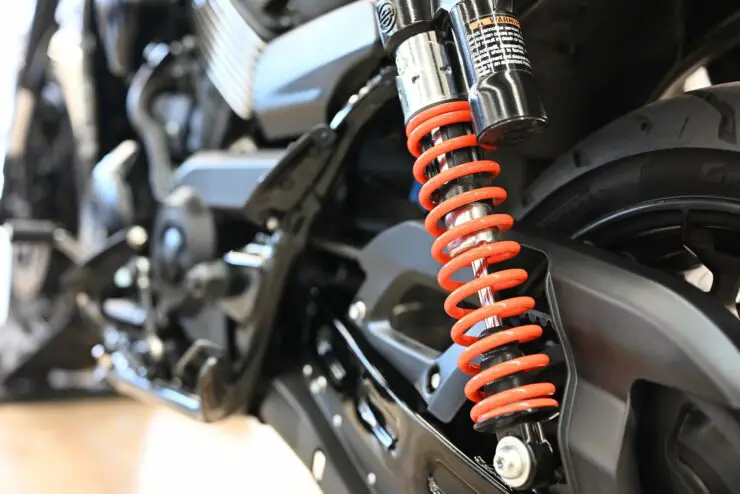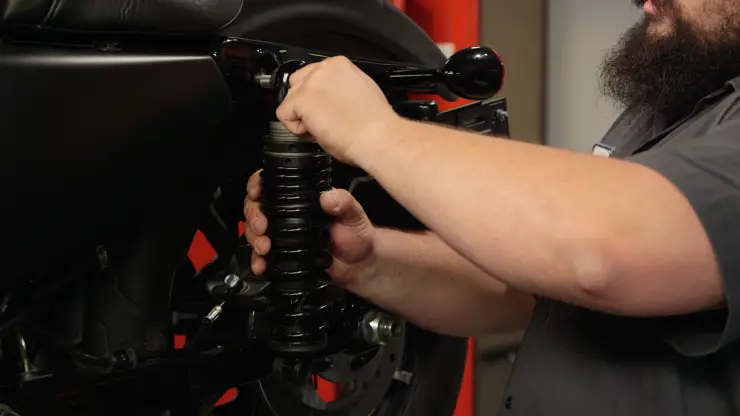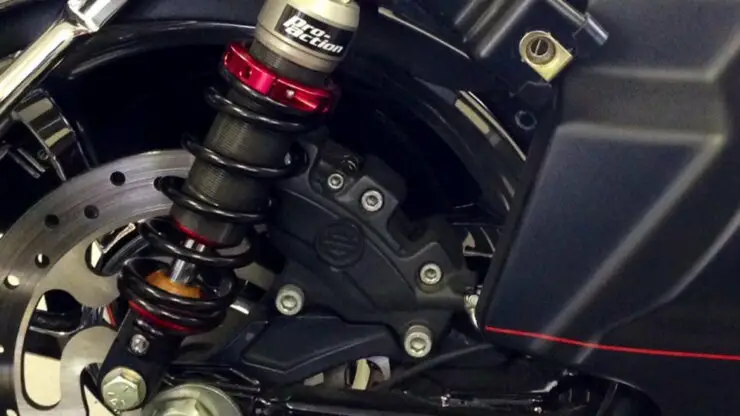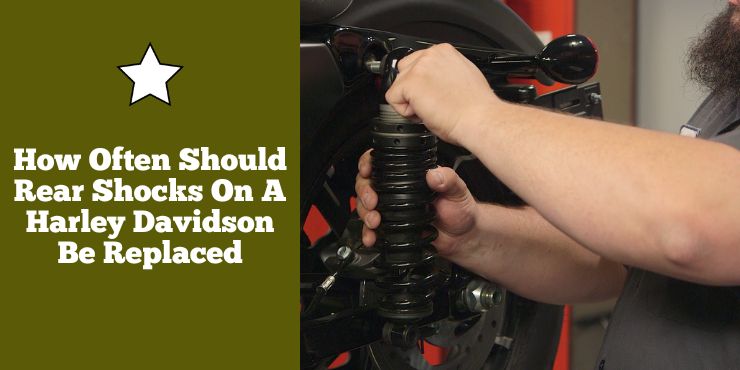If you are a Harley-Davidson owner, you know that the proper maintenance of the rear shocks on your motorcycle is essential for a safe and enjoyable ride. But how often should these shocks be replaced?
Replace Harley-Davidson rear shocks every 20,000-30,000 miles, or sooner if they show signs of wear, like leaking oil or reduced responsiveness.
In this article, we will answer this question and provide you with the information you need to keep your bike in top condition. Read on to find out how often you should be replacing your rear shocks and the importance of doing so.
Rear Shocks on a Harley-Davidson bike
Harley-Davidson bikes are renowned for their iconic design and powerful engines. When talking about its different components, rear shocks are pivotal in contributing to a smooth and comfortable ride. Rear shocks play a key role in absorbing road imperfections and ensuring stability and control for the rider.
>>> Click here to read our review of the Best Rear Shocks For Harley-Davidson <<<
Rear shocks or also known as rear suspension or shock absorbers are essential components of a motorcycle’s suspension system. In Harley-Davidson bikes, they are part of the rear suspension setup responsible for providing a balanced and comfortable ride. Rear shocks work in conjunction with the front suspension to minimize the impact of bumps, potholes, and rough road surfaces, creating a smooth and stable ride for the rider and passenger.
The primary function of rear shocks is to dampen the movement of the suspension. When the motorcycle encounters bumps or road irregularities, the rear wheel moves up and down. Without shock absorbers, this movement will transfer directly to the rider, causing reduced control and discomfort. Rear shocks act as dampers, absorbing the kinetic energy generated by the suspension movement and dissipating it through hydraulic or gas pressure. This process ensures that the rear wheel stays in contact with the road, maintaining stability and enhancing traction.
Harley-Davidson bikes employ different types of rear shocks, depending on the model and customization options. The most common types are coilover and air suspension systems. Coilover shocks consist of a coil spring surrounding a piston that moves within a cylinder filled with hydraulic fluid. When the rear wheel moves, the coil spring compresses or extends, and the hydraulic fluid dampens the movement, providing the necessary resistance to maintain a smooth ride. Harley-Davidson’s coilover shocks are adjustable, allowing riders to fine-tune the suspension for their specific comfort and handling preferences.
Harley-Davidson motorcycles offer air suspension systems, which use compressed air to adjust the rear suspension’s stiffness and ride height. Riders can adjust the air pressure in the shock absorbers to achieve the desired level of comfort and control. Air suspension systems are popular for their versatility as they can easily accommodate various rider weights and payloads.
On many Harley-Davidson models, the rear shocks come with preload adjustment options. Preload refers to the amount of tension applied to the coil spring. By adjusting the preload, riders can tailor the suspension to their weight and riding conditions. Heavier riders or those carrying additional loads can increase the preload to ensure optimal suspension performance, while lighter riders can reduce it for a softer ride.

How often should rear shocks on a Harley-Davidson be replaced?
The rear shocks of a Harley-Davidson bike play a significant role in providing a smooth and stable ride. Over time, like any mechanical component, rear shocks can experience wear and tear. Regular maintenance and timely replacement are essential to ensure optimal performance and ride quality. As a Harley-Davidson rider, you will likely wonder how often should rear shocks on a Harley-Davidson be replaced. The answer is simple and complicated at the same time.
The recommended interval for replacing rear shocks on a Harley-Davidson motorcycle can vary depending on the model, riding conditions, and individual maintenance practices. As a general guideline, many motorcycle experts recommend inspecting the rear shocks annually or every 10,000 to 15,000 miles.
During routine inspections, you should look for signs of wear, leakage, or reduced shock-absorbing capabilities. If you’re noticing any of these warning signs, it might be time to replace the rear shocks –
- Leaking fluid – The presence of oil or fluid around the shock absorbers indicates a potential internal seal failure
- Visible damage – Physical damage such as cracks, dents, or bent components can compromise the effectiveness of the rear shocks
- Reduced performance – If you’re noticing increased bouncing, bottoming out, or instability during rides, it might indicate that the rear shocks are no longer performing optimally
- Rust corrosion – Excessive rust or corrosion on the rear shocks can hinder their ability to function correctly
- Excessive mileage – If your Harley-Davidson bike has covered a higher number of miles or has been in use for many years, it might be time to consider replacement
As a rule of thumb, you should always refer to the manufacturer’s guidelines and recommendations in the owner’s manual for your specific Harley-Davidson model. The owner’s manual will often provide maintenance schedules and replacement intervals for various components, including the rear shocks.
Factors that affect the replacement intervals of rear shocks
As an essential component of a Harley-Davidson motorcycle’s suspension system, rear shocks play a huge role in giving you the desired ride quality. The longevity and performance of these rear shocks can be greatly influenced by different factors, including usage patterns, and more. Here are the different factors that affect the replacement intervals of rear shocks on a Harley-Davidson motorcycle, helping you optimize your riding experience.
Age of rear shocks
The age of rear shocks is a significant factor affecting their performance and potential replacement. Over time, exposure to various riding conditions, weather elements, and continuous use can lead to wear and tear on the internal components of the rear shocks. The materials used in rear shock construction might also experience degradation over time.
As rear shocks age, their ability to effectively absorb impacts and vibrations might diminish. Seals and other internal components might start to wear out, leading to potential fluid leaks or reduced shock-absorbing capabilities. In some situations, older shocks might not provide the level of comfort and stability that a rider desires, warranting replacement to maintain an optimal riding experience.
Usage patterns
The usage patterns of a motorcycle, including riding conditions and load-carrying habits, significantly impact the wear and tear normally experienced by the rear shocks over time.
Frequent exposure to rough or uneven roads, gravel, or off-road riding can accelerate wear on the rear shocks, resulting in a shorter lifespan. Consistently riding with heavy loads or carrying a passenger can put additional strain on the rear shocks, potentially shortening their life span.
Aggressive riding, such as hard braking, rapid acceleration, or taking sharp turns at high speeds, can put added stress on the rear shocks, affecting their performance. Bikers who regularly engage in intense or demanding riding activities might find that their rear shocks require replacement sooner than those who engage in more moderate riding habits.
Care and maintenance
The level of care and maintenance given to the rear shocks is important in determining their longevity and replacement intervals. Regular maintenance practices will help identify and address potential issues before they become severe problems. Proper care and maintenance will include –
- Regular inspections – Periodically inspecting the rear shocks for signs of wear and tear, damage, or fluid leaks can help identify any issues early on
- Cleaning – Keeping the rear shocks clean from debris, mud, and road grime can prevent accelerated wear and potential damage
- Lubrication – Ensuring that moving parts are lubricated adequately can contribute to smoother shock operation and longevity
- Proper adjustment – Adjusting the rear shocks to suit the rider’s weight and intended riding conditions can help optimize their performance
- Timely repairs – Addressing any identified issues promptly and performing relevant repairs can prevent further damage and extend the rear shocks’ lifespan

Benefits of replacing rear shocks on a Harley-Davidson bike
Harley-Davidson bikes are synonymous with the freedom of the open road and the thrill of riding. Numerous components work in conjunction to give you the ride that you desire. One of those components that contributes to the comfort, stability, and control of the bike is the rear shocks. However, you need to replace the rear shocks from time to time to make sure you continue to get a smooth and thrilling riding experience. Here are some of the benefits of timely replacing rear shocks on your Harley-Davidson bikes, and how it elevates the riding journey to a whole new experience.
#1. Improved comfort and ride quality
One of the main benefits of replacing the rear shocks of a Harley-Davidson motorcycle is the enhanced comfort they provide to the rider and passenger. As the bike encounters bumps, potholes, and uneven road surfaces, the rear shocks absorb the impact, reducing the jarring effects transmitted to the rider. This dampening effect ensures a smoother ride, minimizing fatigue and discomfort during extended journeys.
Harley-Davidson’s rear shocks are designed to strike a balance between responsiveness and compliance, allowing riders to tackle both urban roads and open highways with ease. The improved ride quality translates into a more enjoyable and relaxed experience on the saddle, making the journey itself a pleasure.
#2. Enhanced stability and handling
Another advantage of replacing rear shocks on a Harley-Davidson motorcycle is the improved stability and handling they offer. By maintaining the rear wheel’s contact with the road surface, rear shocks ensure optimal traction and control, especially during cornering and maneuvering.
As the rear shocks absorb the vertical movement of the rear wheel, they prevent excessive bouncing or wobbling, creating a more stable platform for the rider. This stability instills more confidence in the rider, allowing them to take on curves and turns with control and precision. Whether cruising on scenic routes or navigating city streets, the enhanced handling afforded by rear shocks contributes to a safer and more enjoyable ride.
#3. Potential of customizability and personalization
Harley-Davidson motorcycles are known for their customizability, allowing riders to tailor their motorcycles to suit their preferences and riding style. Replacing rear shocks gives you the opportunity to take advantage of the customization process. Upgrading to customized adjustable rear shocks allows riders to fine-tune the suspension to match their weight, riding habits, and intended road conditions.
The ability to adjust the preload on rear shocks allows riders to accommodate different payloads, such as additional luggage or a passenger, without compromising on road quality. This personalization aspect ensures that each Harley-Davidson rider can optimize their motorcycle’s performance to match their unique preferences, making the bike an extension of their own personality.
#4. Versatility for different riding conditions
Harley-Davidson bikes are designed to handle different riding conditions, from smooth highways to rough terrains. By replacing rear shocks, you will be able to adapt to diverse environments better. Whether cruising on a long stretch of highway, navigating urban streets, or venturing off-road, replacing rear shocks and keeping them updated will give you the adaptability needed for a versatile riding experience.
For Harley-Davidson riders who enjoy long-distance touring, the comfort provided by replacing the rear shocks will allow you to have extended periods on the saddle with minimal fatigue. Moreover, riders looking for a more responsive and agile ride for city commuting or spirited riding can customize and adjust the replaced rear shocks to suit their needs.
Preparation before replacing rear shocks on a Harley-Davidson bike
Replacing rear shocks on a Harley-Davidson bike can be a rewarding prospect that enhances the bike’s performance and ride quality. However, it is important to be well-prepared with the right tools and follow the proper preparatory steps to ensure a smooth and successful installation. Here are some of the tools you’ll require and the preparatory steps to carry out before you can start replacing rear shocks on your Harley-Davidson bike.
Tools needed for replacing rear shocks
- Motorcycle lift or stand – To provide adequate clearance and accessibility to the rear shocks, you’ll require a motorcycle lift or stand to elevate the rear wheel off the ground
- Torque wrench – A torque wrench is important for tightening the new rear shock absorbers to the manufacturer’s recommended specifications, ensuring proper installation and safety
- Socket and wrench set – A comprehensive socked and wrench set will be needed for removing various nuts, bolts, and fasteners during the replacement process
- Screwdrivers – Different screwdrivers such as Philips and flat-head will be needed for various tasks during the replacement process
- Pliers – Pliers are handy for gripping and holding components during disassembly and assembly
- Allen and Hex key set – An Allen key set or hex key set will be required for removing and installing specific components on the bike
- Lubricant – Using lubricant on certain parts, such as rubber mounts or bushings can help in smooth assembly and reduce friction
Preparation to carry out
Here are the preparatory steps you will need to carry out before you can start replacing the rear shocks on your Harley-Davidson bike –
#1. Lift and secure the bike
Use a motorcycle lift or stand to elevate the rear wheel off the ground. You should secure the motorcycle to the lift or stand to prevent any movement during the replacement process. Make sure that the motorcycle is stable enough and secure.
#2. Inspect the components
Take the opportunity to inspect other components around the rear shocks, such as mounts, bushings, and fasteners. You need to replace any worn or damaged parts as required.
#3. Safety gear
You should not forget to wear safety gear, including safety glasses and a pair of safety gloves. Wearing the necessary safety gear will help protect you during the replacement process.
#4. Consult the service manual
Refer to your Harley-Davidson bike’s service manual for specific instructions and guidelines for rear shock replacement. The service manual will provide step-by-step procedures, torque specifications, and any other important information for the task.
How to remove old rear shocks on your Harley-Davidson motorcycle?
As a Harley-Davidson motorcycle enthusiast, taking care of your motorcycle’s suspension system is important for a smooth and comfortable ride. If you have noticed signs of wear or reduced performance in your rear shocks, it might be time to replace them. Removing old rear shocks is an important step in the replacement process and with the right tools and instructions, you’ll be able to tackle this task with confidence. Here are the steps you will need to follow to remove old rear shocks on your Harley-Davidson bike.
Step 1: Remove the necessary components
Depending on your specific Harley-Davidson bike model, you might have to remove certain components to access the rear shocks. Common components to remove include the seat, saddlebags, and rear fender. Refer to your Harley-Davidson bike’s service manual for instructions on removing these parts.
Step 2: Locate and disconnect the shock bolts
Locate the upper and lower shock mounting bolts on both sides of the rear suspension. These bolts connect the shock absorbers to the motorcycle frame and swingarm. Make use of the appropriate socket and wrench to loosen and remove these bolts. Depending on the type of rear shocks, there might be additional mounting hardware or brackets to disconnect.
Step 3: Lower the motorcycle
Once the shock bolts are removed, lower the bike carefully to the ground. Make sure that you’re doing this slowly and steadily to avoid any sudden movements.
Step 4: Remove the old rear shocks
With the motorcycle on the ground, you’ll now be able to remove the old rear shocks. Gently pull the shocks away from the motorcycle fame and swingarm, using a rubber mallet or soft hammer to tap them if needed. Pay close attention to how the shocks are mounted as this will guide the installation of new rear shocks.
Step 5: Inspect and clean
Take the opportunity to inspect the removed rear shocks for signs of wear, leaks, or damage. If the rear shocks are damaged or beyond repair, it’ll be time to replace them with new ones. Moreover, clean the mounting areas on the frame and swingarm to ensure a smooth installation of the new rear shocks.

How to install new rear shocks on your Harley-Davidson bike?
Installing new rear shocks on your Harley-Davidson bike can be an exciting change that enhances your motorcycle’s performance and comfort. Whether you are upgrading to improve handling or replacing worn-out shocks, proper installation will be important for optimal results. Here are the steps you will need to follow for installing new rear shocks on your Harley-Davidson bike, ensuring a smooth and enjoyable ride on the open road.
Step 1: Inspect the new shocks
Before installation, you should inspect the new rear shocks for any signs of damage or defects. Make sure that all mounting hardware and components are included and in good condition.
Step 2: Determine the orientation of the new rear shocks
Determine the correct orientation of the new rear shocks based on your Harley-Davidson model and the type of rear shocks being installed. Some rear shocks might have specific mounting requirements, such as specific sides for the upper and lower mounts.
Step 3: Position the new rear shocks
Gently position the new rear shocks into place on the motorcycle’s frame and swingarm. Pay close attention to aligning the rear shocks’ mounting holes with the corresponding holes on the frame and swingarm.
Step 4: Secure the rear shocks
Insert the mounting bolts through the rear shocks’ mounting holes and the corresponding holes on the frame and swingarm. Make use of the appropriate socket and wrench to tighten the bolts securely. Be careful that you don’t end up overtightening the bolts as it can end up damaging the rear shocks or mounting points.
Step 5: Torque to specifications
Using a torque wrench, you should tighten the mounting bolts to the manufacturer’s recommended torque specifications. This will ensure that the rear shocks are securely fastened without risking damage due to overtightening.
Step 6: Lower the motorcycle
With the new rear shocks installed securely, you should lower the motorcycle from the lift or stand. Make sure that you’re doing this slowly and carefully to avoid any sudden movements.
Step 7: Test and adjust
Take your Harley-Davidson bike for a test ride to evaluate the performance of the new rear shocks. Pay close attention to your Harley-Davidson motorcycle’s handling and ride quality. If needed, you should make the necessary adjustments to the preload settings or other parameters for achieving the desired ride characteristics.
FAQ
How often should rear shocks on a Harley Davidson be replaced?
Rear shocks on a Harley Davidson should be inspected and serviced regularly and replaced when they become worn or damaged. It is recommended that shocks be inspected every 10,000 miles and replaced every 15,000 miles. It is also important to note that shocks may need to be replaced sooner depending on the type of riding conditions and the weight of the rider.
What signs indicate that rear shocks on a Harley Davidson need to be replaced?
Signs that rear shocks on a Harley Davidson need to be replaced include excessive wear, leaking oil, or excessive bouncing. If the shocks are not replaced when they become worn or damaged, it can lead to decreased handling performance and increased risk of an accident.
What are the benefits of replacing rear shocks on a Harley Davidson?
Replacing rear shocks on a Harley Davidson can help improve overall handling and ride comfort, as well as reduce rider fatigue and the risk of accidents. Replacing shocks can also help improve the suspension performance, leading to better handling, cornering, and braking.
>>> Read more about Rear Shocks for Harley-Davidson <<<

